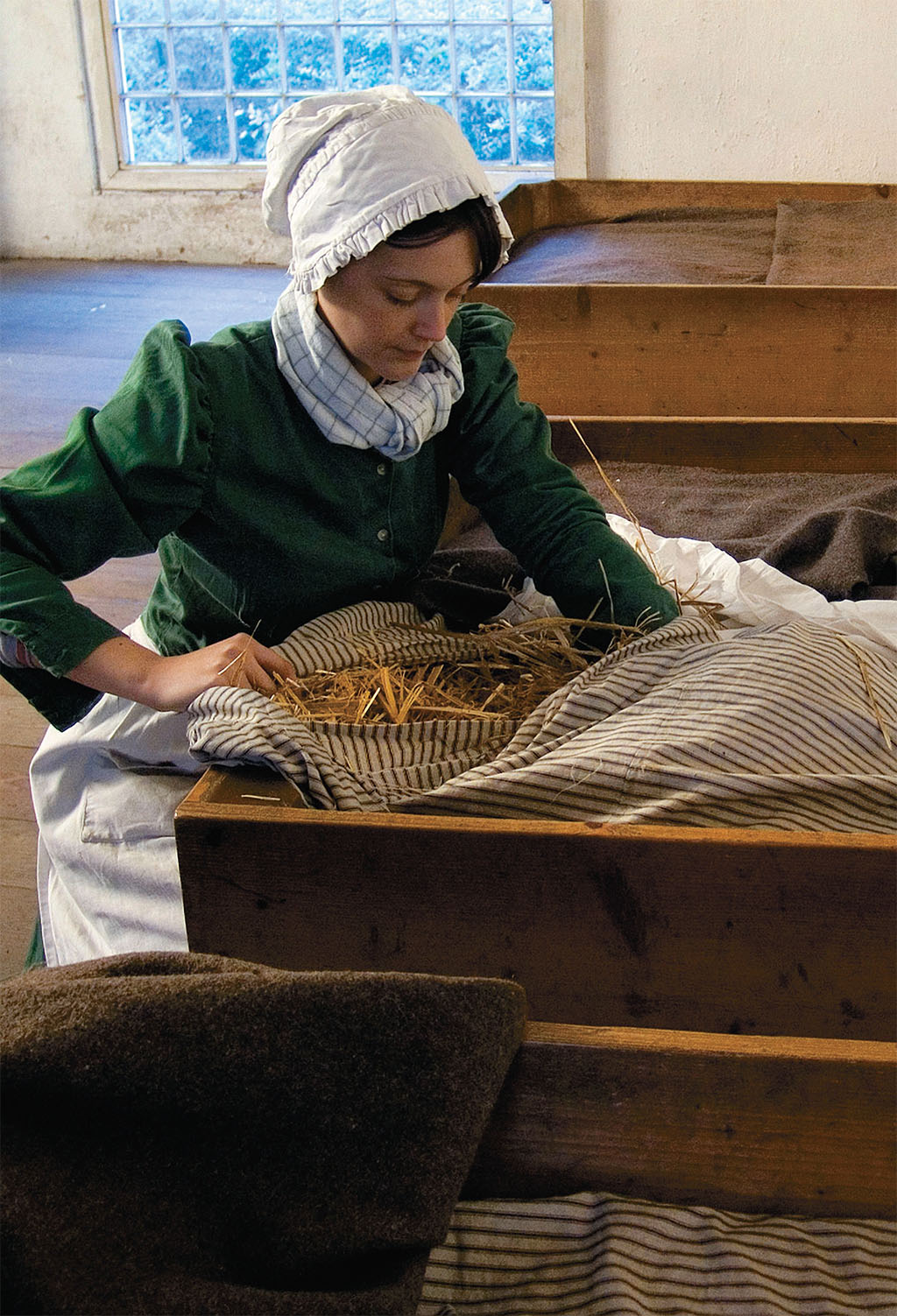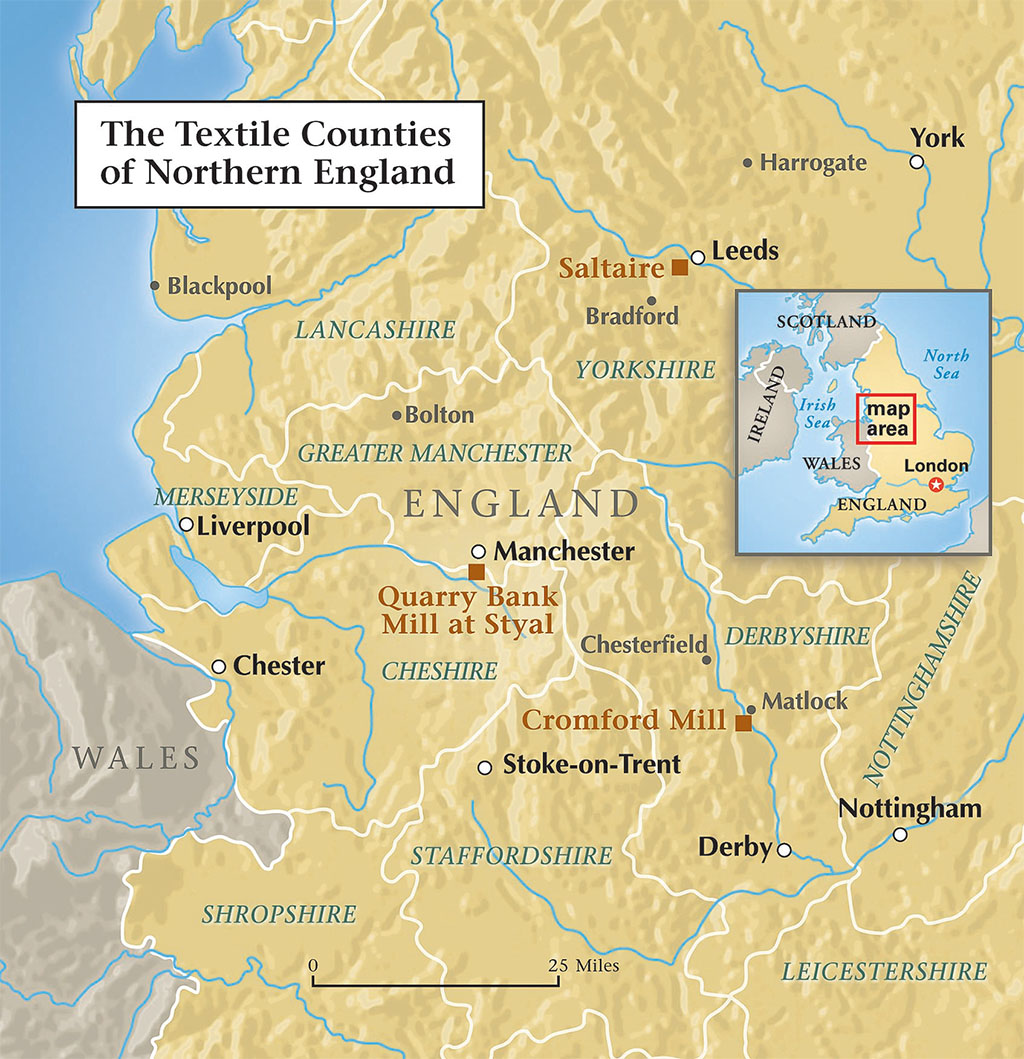
HOW DID BRITAIN COME TO DOMINATE THE GLOBAL PRODUCTION OF CLOTH?
Industry & Empire Third in a Series
[caption id="BritishTextilesClothetheWorld_Feature" align="aligncenter" width="1024"]

©NTPL/IAN SHAW
[caption id="BritishTextilesClothetheWorld_img1" align="aligncenter" width="315"]

BY THE MIDDLE OF THE 19th century, Britain was producing half the world’s cotton cloth in giant mills that dotted the valleys and dominated many towns in the north of England. The largest was Quarry Bank Mill at Styal in Cheshire, which alone met 0.6 percent of world demand. Yet not a scrap of cotton was grown in Britain. How then did Britain come to dominate global production of a cloth made entirely from material imported from the southern United States, India and Egypt? The answer lies in a set of circumstances no less complex than the finely woven, beautifully printed British muslins, calicoes and chintzes that clothed people and furnished homes everywhere.
Britain had long manufactured textiles. The damp climate is good for grazing sheep, so for centuries the country was renowned for its fine woolens. Flax, the raw material for linen, also thrives in rain. Linen and wool were used to make the linsey-woolsey worn by all but the richest people in the Middle Ages and Renaissance. Silk, introduced by French Protestant silk workers fleeing persecution in the 17th century, was also made in Britain, mostly in London.
Textile workers plied their craft at home, sometimes to supplement farming. Women spun yarn, often helped by children. The yarn then went to a weaver, usually a man, who might be another family member weaving cloth for the household. More likely, both spinsters and weavers worked on the “putting out” system: A merchant supplied the raw fiber and then picked up the finished goods for sale elsewhere.
Traditionally, one handloom weaver needed the yarn output of four spinsters. But by the mid-18th century, many weavers were using the flying shuttle that had been invented by John Kay of Bury, Lancashire, in 1733. By speeding the shuttle across the loom and freeing one of the weaver’s hands, this invention upped the demand for yarn; one worker could now weave the output of 16 spinsters. With cloth in demand both at home, where the population was increasing, and abroad, where British colonies were a captive market, improved spinning methods were essential to meet the need for cloth.
Wool production was difficult to mechanize because centuries-old laws protected traditional ways of making it. Conversely, by the 1740s silk was already being machine-made in factories in Derby and Macclesfield with equipment based on pirated Italian designs. But silk was too delicate and expensive for mass consumption. Cotton, on the other hand, was hard-wearing, comfortable and inexpensive. Unlike wool, its production was not controlled by ancient practices because it had only become widely available after the East India Company began exporting it from India in the late 17th century. Inventors therefore bent their minds to creating cotton-processing machines, and cotton spearheaded British industry into the factory system.
The first major improvement in spinning technology was the spinning jenny, introduced in 1764 by Thomas Highs (1718-1803) of Lancashire and named for his daughter. Highs wanted a machine for spinning cotton that would multiply threads more quickly, and he built a device with six spindles. James Hargreaves (1720-78), who is widely credited for inventing the spinning jenny and was also from Lancashire, apparently “improved” Highs’ design by adding more spindles. Hargreaves acquired the patent for it in 1770, but by then the device had been widely copied. By the time of Hargreaves’ death, more than 20,000 spinning jennies were in use. It spun yarn from between 20 and 30 spindles at one time, thus doing the work of several spinsters’ a prospect that had made Hargreaves so unpopular in his neighborhood that a mob destroyed his spinning jennies and ran him out of town.
[caption id="BritishTextilesClothetheWorld_img2" align="aligncenter" width="1024"]

BLUE MARBLE MAPS, LLC
The next development was the water frame, again largely conceived by Highs, who now wanted a machine for the spinning of twist by rollers. Richard Arkwright (1732-92), a Lancashire barber interested in weaving wigs, obtained one of Highs’ water frame models and built a fullsize machine that used three or four sets of rollers to draw out the cotton before it was twisted. In 1769 Arkwright obtained the patent for the water-powered device. Threatened by workers who would be put out of business by the invention, Arkwright left his native Lancashire for Nottingham, where he met Jedediah Strutt, who had improved the 16th-century machines that knit cotton for stockings. With his efficient new knitting machines, Strutt needed more cotton yarn, so he teamed with Arkwright to build the water frames in new water-driven mills they built in Cromford, Derbyshire, in 1771.
Samuel Crompton (1753-1827), also of Lancashire, further improved spinning with a dual set of rollers that drew out the yarn into a fine, soft, even filament. Since it used both the rolling action of the water frame and the drawing action of the spinning jenny, Crompton’s hybrid machine was called a “mule.” A single operator could now work more than 1,000 spindles simultaneously. Factories equipped with mules made the Lancashire town of Bolton into the world center for the finest cotton yarns. Crompton never did patent the mule, in part because the wording in Arkwright’s water-frame patent made it difficult if not impossible. Eventually, in 1785, after prolonged litigation, Arkwright lost his patent rights, by a decision of the Court of King’s Bench, and other manufacturers were able to use the water frame freely.
By the 1780s the new spinning machines were producing so much yarn that inventors turned to the mechanization of the loom. Weaving was a series of carefully timed steps, and weavers needed to watch the loom constantly so that if a thread broke or ran out of the shuttle, they could stop and repair it immediately before a disaster occurred. Many Manchester manufacturers therefore thought that mechanization was impossible. Hearing this, a man of the cloth, the Reverend Edmund Cartwright (1743-1823) of Melton Mowbray in Leicestershire, decided to prove them wrong—even though he had no weaving experience and had never even seen anyone weave!
Cartwright’s first power loom worked, but one moving part weighed more than 50 pounds and the springs threw the shuttle so fast that two strong men were needed to tend it. This was not suitable for cost-conscious Manchester businessmen. Nevertheless, Cartwright patented his machine in 1785, the same year Arkwright’s patent was revoked.
Cartwright began to watch weavers at work, and based his next loom, invented between 1786 and 1788, on their actions. Still, his device required full-time attention. Cartwright then invented a warp protector that instantly stopped the loom when a problem occurred, and he began to produce fabric mechanically.
All these 18th-century machines needed vast supplies of cotton. In the 1790s, the first newly planted cotton came from American plantations manned by slaves. The raw cotton had to be cleaned before it could be used by the fast-moving equipment, but it was taking a full day for one person to remove the seeds from one pound of cotton. Eli Whitney, a New Englander, solved that problem with his cotton gin, which used a series of steel disks fitted with hooks to drag the cotton through slots in a grid, leaving the seeds behind. This invention both spurred the Industrial Revolution in Britain and induced Southern planters in America to grow more cotton.
Britain not only had clean supplies of American cotton and an array of machines to handle every stage of making it into cloth, it also had good power supplies. Eighteenth-century machines typically used water power, hence the siting of early factories near the fast-flowing rivers of the Pennines. But after James Watt invented the steam engine in 1781, coal became the main fuel. Serendipitously, England’s richest mines were also near the Pennines in Lancashire, Yorkshire, Nottinghamshire and Derbyshire. Thus, these northern areas became the textile strongholds of the country.
The new machinery ended the traditional domestic system of textile production. Machines had to be close to their power source; they could not be in cottages. Moreover, different machines sequenced to perform specific tasks required both a division of labor and specialized skills. Workers therefore had to follow strict rules about work and punctuality.
Some mills specialized in one textile-making process, but others, such as Quarry Bank Mill at Styal, established in 1784, performed all the needed tasks to turn cotton fiber into cloth. At Quarry Bank Mill, nearly half the workers were children between the ages of 7 and 21, most from workhouses and orphanages who were contracted to work for a period of seven years as apprentices. By 1800 there were 90 children who lived and worked without pay at the mill, learning the trade as the reward for their work, although there was no significant effort to teach them the trade; mostly they were regarded as a source of cheap labor.
Children were essential in textile factories because they were small enough to scramble under the looms to clean them or retie broken threads. Records from Quarry Bank Mill contain details of nearly 1,000 children who worked there between 1785 and 1847. Their day began early. They typically rose at 5:30 a.m., were given a piece of bread to eat and began work at 6. Through the day, they usually had three short breaks, when they were fed oatmeal, and then at 8:30 p.m., after finishing their 141/2-hour shift, they got a supper of bread or broth. On Sundays, they had reading lessons, church and chores, such as tending the owner’s vegetable gardens.
BRITAIN HAD CLEAN SUPPLIES OF AMERICAN COTTON, AN ARRAY OF MACHINES TO MAKE IT INTO CLOTH AND GOOD POWER SUPPLIES.
[caption id="BritishTextilesClothetheWorld_img3" align="aligncenter" width="1024"]

SCIENCE AND SOCIETY PICTURE LIBRARY
The unpaid apprentices sometimes ran away. About 100 appear to have fled from Quarry Bank Mill. A notice describing fugitives Esther Price, 14, and Thomas Priestley, 13, read: “Whoever will apprehend the said Apprentices, and give information thereof…shall receive one guinea reward and be paid all reasonable expenses. Both apprentices committed this crime last night and are believed to be still hiding in the mill. Can you find them?” The guinea reward (21 shillings) would have been more than a week’s pay for many workers. Once recaptured, apprentices frequently were beaten, had their hair cropped and had to work overtime to make up missed work and repay the costs of finding them. When Price was located and returned, she was forced to live in a room with boarded-up windows. Priestley, recovering from having one of his fingers torn off at the mill, was asked by the magistrate why he ran away. “I thought of my mother,” he said.
Life was equally hard for adult factory workers. Until 1833, hours of employment were not regulated, and it was 1844 before the law insisted that the machinery had to be fenced to prevent death and dismemberment. The thunderous noise of the machinery never ceased, so most older workers became deaf. Lung diseases were also prevalent, caused by the minute fiber fragments in the air. Few adults could leave the mills, especially when whole cities were devoted to textiles and little other work was available.
The similarity to the conditions of America’s slaves was not lost. Harriet Beecher Stowe noted it when she visited England in the 1850s. The workers, too, saw the comparison. During the American Civil War, only 40,000 of the 355,000 cotton operatives in Lancashire were working full time. As elucidated in the Illustrated London News on November 22, 1862, “The mills cannot be put to work until cotton is forthcoming, and the appearance of that substance does not depend on us, but on the continuance of the blockade of southern ports.” Nonetheless, the magazine lauded the British government’s support of the North, and encouraged its readers to heed “Lancashire’s cry of distress” by sending financial aid. The workers themselves, though out of work, met in Manchester’s Free Trade Hall on New Year’s Eve 1862 to pledge their support for the Union forces. President Abraham Lincoln, aware of their sacrifices, responded quickly, sending the workers a letter of thanks just three weeks later. His statue still stands in Manchester.
One reason unemployed workers opposed the slavery on the plantations was that they were used to com combating their own hideous working conditions. Earlier, weavers had fought the introduction of technology that put them out of work, often by breaking machines and burning factories. Wool and linen workers were for a while successful because their trades were protected by local guilds. But this restraint was overcome when the woolen trade, historically based in East Anglia with Norwich as its center, moved to Yorkshire, where guild practices were less stringent.
BRITISH COTTON MACHINES JUMP-STARTED AMERICA’S INDUSTRIAL REVOLUTION.
Even so, the woolen industry lagged 30 years behind the cotton industry in mechanization, partly because machines invented for making cotton had to be modified before they could be used for wool or other fibers. Indeed, machines for wool needed adapting for different kinds of wool, as Titus Salt discovered in the 1830s when he devised a way to handle the intractable but much-prized wool of the alpaca. As a result he became so wealthy that in 1851 he began work on his model village of Saltaire (see “The Town that Titus Built,” July 2006 BH).
By this time, British cotton machines had long since jump-started America’s industrial revolution. Samuel Slater of Derbyshire had worked with Arkwright and Strutt, but realizing he had little chance of a partnership, he responded to an advertisement offering £100 bounties to English mill workers prepared to emigrate to America. He took with him the secrets of the water frame and—just as significant—the management techniques of continuous factory production that Arkwright and Strutt had pioneered. In America, Slater teamed with Moses Brown, who had been experimenting with machinery in Providence, R.I., and introduced him to the water frame. In 1790, they built a new water-powered factory in Pawtucket, R.I., and in 1797 Slater built the White Mill on the Blackstone River and later a workers’ village called Slatersville.
[caption id="BritishTextilesClothetheWorld_img4" align="aligncenter" width="1024"]

WWW.BRITAINONVIEW.COM/ALAN NOVELLI
Francis Cabot Lowell of Massachusetts traveled to England in 1810 to tour Manchester’s mills, just as they were being fitted with power looms. He gleaned enough so that in 1814 he built the first mill in America capable of transforming raw cotton into finished cloth, located on the Charles River at Waltham, Mass. Four years after Lowell’s death in 1817, the firm moved to a site on the Merrimack River, where a new town named Lowell in his honor soon became the center of America’s cotton industry.
By 1840 Lowell had 10 mills employing more than 40,000 workers, mainly young women. Many were from England. The textile business in Britain, though successful, went through economic cycles. The 1840s were so grim that they were known as the “Hungry Forties,” and even after the Civil War ended in 1865, American cotton supplies were uncertain and unemployment remained high. Many textile workers therefore emigrated. English immigrants staffed the sorting rooms of the mills in Lawrence, Mass. Contingents of immigrants from Lancashire went to the mills of New Bedford, Mass., and silk workers from Macclesfield in Cheshire left for Paterson, N.J.—a town often called “Silk City,” as was Macclesfield.
Today, the sturdy brick mills built to house the massive textile machinery still stand throughout New England and northern Britain, all turned to new uses. Among those that can be visited in Britain are Quarry Bank Mill, now a magnificently preserved National Trust property; Titus Salt’s village of Saltaire in Morley, Yorkshire; and Paradise Mill and the Silk Trail at Macclesfield, Cheshire. There remains one original water frame, at the Helmshore Museum, and a quarter of it works, powered by electricity, since the museum does not yet have a working water wheel. These 18th- and 19th-century devices express both the engineering achievements of their inventors and the difficult lives of those who operated them.





Comments